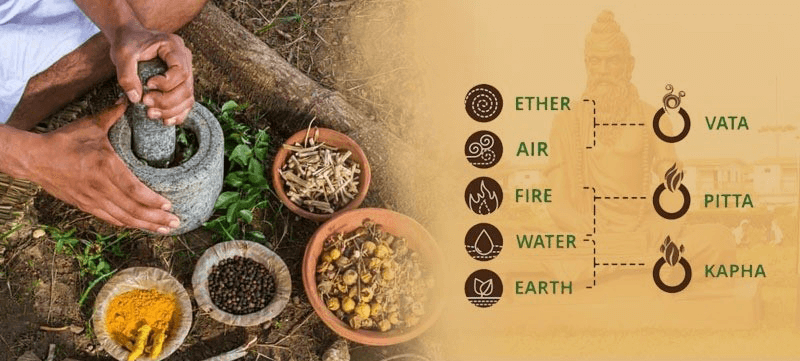- +033 2572 7171
- info@dhanvantary.com

4.5 Rating | 4500 Review

4.5 Rating | 4500 Review
The history of Ayurveda is deeply intertwined with the cultural and spiritual traditions of ancient India, where it is believed to have originated over 5,000 years ago. This traditional system of medicine has evolved through centuries, passed down by sages and scholars and documented in classical texts, reflecting a holistic approach to health and well-being.

Ayurveda has its roots in the Vedic period, and its principles are found within the four Vedas: Rigveda, Yajurveda, Samaveda, and Atharvaveda. The Atharvaveda contains the earliest references to health, disease, and treatments, describing various herbs and natural remedies to cure ailments and maintain health. During this time, Ayurveda was more than just a healing system; it was considered a spiritual science that aligned human life with the laws of nature and the universe.
The knowledge from the Vedic period (3000 BCE To 1500 BC)was further expanded and systematically organized by ancient sages and scholars. Two foundational texts—Charaka Samhita and Sushruta Samhita—were compiled during this period, which would go on to become the bedrock of Ayurvedic medical practice.
Compiled by the sage Charaka, this text focused on internal medicine and detailed various medicinal herbs, lifestyle practices, and dietary guidelines. Charaka described health as a balance of body, mind, and spirit, emphasizing individualized treatment.
Attributed to the sage Sushruta, this text is recognized as one of the earliest works on surgery. Sushruta documented numerous surgical techniques, including procedures like rhinoplasty, suturing, and more. This knowledge of anatomy, surgical tools, and surgical procedures illustrates Ayurveda’s advanced understanding of human health during this era.
Ayurveda continued to grow and gain prominence in ancient India further from 1500 BCE to 500 BCE. New texts and treatises were written to expand on the knowledge within Charaka Samhita and Sushruta Samhita, with notable works like the Ashtanga Hridaya by Vagbhata. This text synthesized previous knowledge and outlined the "eight branches of Ayurveda" (Ashtanga Ayurveda), including internal medicine, surgery, paediatrics, psychiatry, and toxicology.
Buddhist and Jain influences also contributed to the spread of Ayurveda beyond India, especially to Central Asia, Tibet, and Southeast Asia. Ayurvedic knowledge travelled along trade routes, reaching regions in Southeast Asia and influencing local healing practices.
The Gupta period (300 AD to 700 AD) is considered a golden age of science, literature, and medicine in India. Ayurveda flourished under the patronage of the Gupta rulers, who encouraged the study of medicine and established universities where Ayurveda was taught. Institutions like Nalanda and Takshashila became prominent centers for medical study, attracting students from various parts of the world.
Ayurvedic knowledge during this era included advances in pharmacology, chemistry, toxicology, and medical ethics. The influence of Ayurveda also extended into other fields such as astrology and yoga, creating an integrated approach to holistic health.
During the medieval period (700 AD to 1600 AD), the arrival of Islamic scholars and the establishment of the Mughal Empire brought Unani (Greek-Arabic) medicine to India. This system of medicine coexisted with Ayurveda, and cross-cultural exchanges enriched both systems. However, during this period, Ayurveda’s prominence began to decline as Islamic and later European systems of medicine gained influence.
Ayurvedic practices were still widely used by the general population, but patronage for Ayurvedic institutions waned, and much of the knowledge became localized within families and communities.
The British colonial rule (1600 AD to 1947 AD) had a significant impact on Ayurveda. The British introduced Western medicine to India, viewing it as superior and often dismissing Ayurveda as unscientific. Ayurvedic institutions were neglected, and Ayurvedic practitioners faced restrictions on their practice.
Despite this suppression, Ayurveda remained integral to Indian culture and health care, especially in rural areas. The traditional knowledge was preserved through oral transmission, family lineages, and local healers, allowing Ayurveda to survive.
After India gained independence in 1947, there was a renewed interest in Ayurveda. The Indian government recognized Ayurveda as a legitimate medical system and established regulatory bodies and educational institutions. Research institutions, universities, and hospitals dedicated to Ayurveda were founded, and efforts were made to integrate Ayurveda with modern medicine.
Today, Ayurveda has gained global recognition as a complementary and alternative medical system. Practitioners worldwide incorporate Ayurvedic principles into wellness, diet, and lifestyle practices. With a focus on individualized treatment and preventive care, Ayurveda has aligned well with contemporary health trends, such as holistic wellness, organic products, and mind-body connection.

Ayurveda’s enduring legacy is a testament to its adaptable and comprehensive approach to health. By addressing the balance of body, mind, and spirit, Ayurveda continues to offer valuable insights into wellness that resonate with people globally, emphasizing prevention, harmony, and respect for nature. In recent years, the global interest in alternative and holistic health has revitalized Ayurveda, positioning it as a respected system that complements modern medicine and promotes a balanced, healthy lifestyle.
Ayurveda, derived from the Sanskrit words "Ayur" (life) and "Veda" (science or knowledge), translates to the "science of life." It is one of the world’s oldest holistic healing systems, originating over 5,000 years ago in India. Developed by ancient sages, Ayurveda encompasses physical, mental, and spiritual well-being, emphasizing a preventive approach to health. Its foundational texts, the Charaka Samhita and Sushruta Samhita, describe principles, treatments, and lifestyle practices that continue to influence modern wellness practices globally.
According to Ayurveda, health is a state of balance between body, mind, and soul, guided by the principles of three fundamental energies or doshas—Vata (air and ether), Pitta (fire and water), and Kapha (earth and water). The Sanskrit definition of health, Swasthya, emphasizes balance, as stated in the classic text:
This means: "One is considered healthy when the doshas (bio-energies), agni (digestive fire), dhatus (tissues), and malas (waste products) are in balance, and when the soul, senses, and mind are in a state of contentment." In essence, Ayurveda promotes individualized treatment and lifestyle adjustments, recognizing that each person is unique, and optimal health is achieved by balancing internal and external factors in harmony with nature.
Ayurveda is viewed as the comprehensive science that explores the nature of life, the causes of health and disease, and the methods of treatment for achieving balance and longevity. The definition underscores its holistic approach, integrating physical, mental, and spiritual dimensions of well-being.
